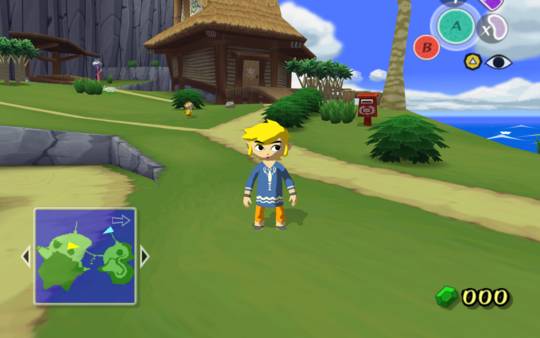Post Tenebras Lux: The Jump from Majora's Mask to Wind Waker
|
Compared to the more earthy visuals of Ocarina of Time and the dark nuances of Majora’s Mask (recently discussed by Nightmare Mode’s own Daryl Heard) Wind Waker can seem an ocean away from its predecessors. The length and breadth of Hyrule – from the windswept sands of the Gerudo Desert to the molten walls of Death Mountain Crater – had been erased from collective memory. In its place was left a vast sea punctuated with scattered islands, their inhabitants clinging to spits of land in an attempt to escape the endless assault of the ocean. The land we’d traversed since Zelda’s inception was gone and survived solely in rumor and legend. Even the former art style seemed to have been forgotten. The fan’s initial reaction was widespread hostility but fast forward a few months and the game was awash with glowing reviews and universal acclaim. The changes may have been condemned but they allowed for Wind Waker to become one of the most memorable, charming and visually appealing entries in the Zelda mythos. From a modern perspective it’s hard to see why Wind Waker was originally so vilified. Such scorn towards its graphics seems ridiculous now, when promoting the need for photo-realism is enough to get you laughed out of the room by the collective games media.
It must be considered that the early 2000’s were the dawning days of a new generation. The PS2 and original Xbox were setting a new graphical standard and the march of progress was firmly in the direction of realism. The era of colourful mascots and cartoony visuals was succeeded by an outcry for more mature titles: more Halo, less Mario. When fans got their first glimpse at Link’s GameCube debut what was delivered was a world away from what was expected. For many this wasn’t progress, this was regression. And then they played it. The oppressive atmosphere of Termina had given way to an air of childlike gusto. The moon still hung loftily in the sky but this time it stayed there, its reflection bobbing up and down upon the inky blue waves. The new art style imbued Wind Waker with an original feel distinct from other Zelda outings. From the darkness of Majora’s Mask was born the light of Wind Waker: polar opposites in terms of tone, identical in terms of charm. Fundamental to Wind Waker’s allure is the mystery of what lies beyond that glistening sea. The starting island of Outset is a rustic as they come. The sort of sleepy, slow moving community that’s content to sit back on the sands and watch the world go by; a lovely spot for a holiday but no place for a hero. Link’s departure may have been to save his sister but all I wanted was to plot a course for adventure. Wind Waker recreates the gung-ho atmosphere made famous by a hundred swashbuckling legends: a slow and dreary life taken over by distant lands blurred through the eyepiece of a telescope, endless seas to find fame and fortune with a merry band of pirates to share the voyage.
Where the opening of Majora’s Mask excels at setting the game’s dark tone, the opening of Wind Waker introduces a refreshing sense of enthusiasm. Link’s boyish naivety and unflinching courage are encapsulated in these short moments. He sheds the pyjamas of childhood and takes on the clothes of a man, despite barely being tall enough to reach the crested shield that adorns his grandmother’s wall. From the safety of home he ventures towards a dark wood on the trail of a mysterious, blonde-haired damsel, hurled into the forest by a monstrous bird. He cuts his way through a few of Gannon’s goons and comes across a scallywag by the name of Tetra, widely regarded as one of Zelda’s greatest incarnations. The bird then snatches up Link’s sister and a begrudging Tetra is drafted in to tail his sister’s kidnapper. The island home of our young hero then drifts off into the distance as we make our way onto the high seas and towards the great unknown. The claustrophobic introduction to Majora’s Mask is juxtaposed nicely by the openness of Wind Waker’s ocean. The ship’s sails are filled with a biting wind that acts as both a literal and metaphorical breath of fresh air as our Louis Stevenson-esque voyage gets fully underway. On the surface the two seem diametrically opposed, but Majora’s Mask and Wind Waker prove to have a lot more in common than you might think. Both were radical shifts from the Zelda universe established up through Ocarina of Time, turning their backs on conventional Hyrule in favour of separate worlds of their own. The vibrancy of Wind Waker perfectly counterbalances the darkness of Majora’s Mask resulting in a pair that complement each other perfectly. They both diverged from the path and offered up something truly unique amongst the Zelda canon, where other games (Twilight Princess in particular) strike as playing it safe. They may have been risky undertakings, but in the end, the wind had certainly blown in Nintendo’s favour. After Pressing Start is a series running on Nightmare Mode every Friday by resident narrative guru Tom Auxier. It focuses on beginning, on the stories that happen directly after pressing start, and how those introductory stories influence the arcs of video games. This guest entry of After Pressing Start was written by Chris Waldron. Check out some of the other APS articles: After Pressing Start |
_(En,Fr,De,Es,It)-1.jpg)
 “The oppressive atmosphere of Termina of had given way to an air of childlike gusto”
“The oppressive atmosphere of Termina of had given way to an air of childlike gusto”  “The claustrophobic introduction to Majora’s Mask is juxtaposed nicely by the openness of Wind Waker’s ocean”
“The claustrophobic introduction to Majora’s Mask is juxtaposed nicely by the openness of Wind Waker’s ocean”